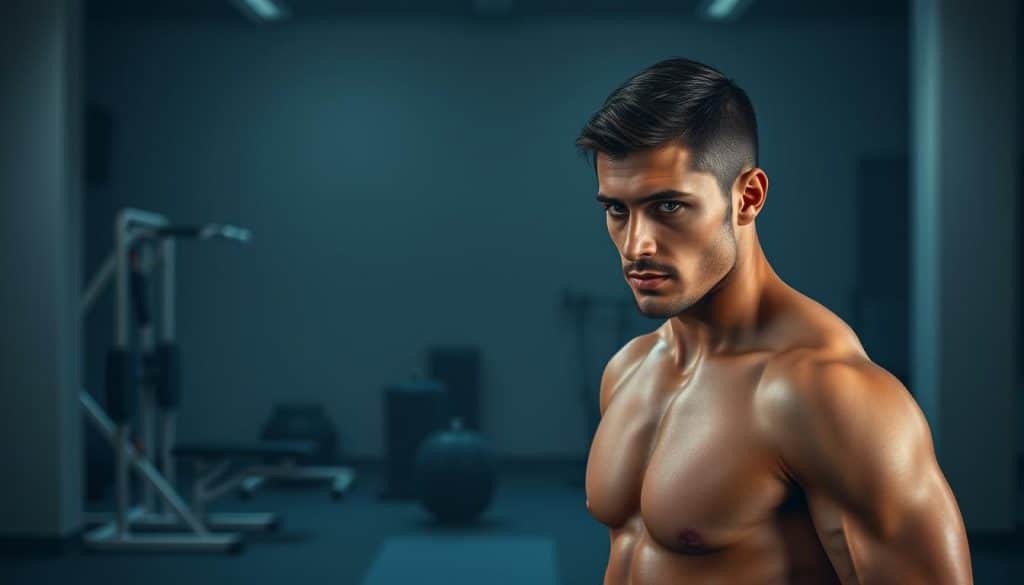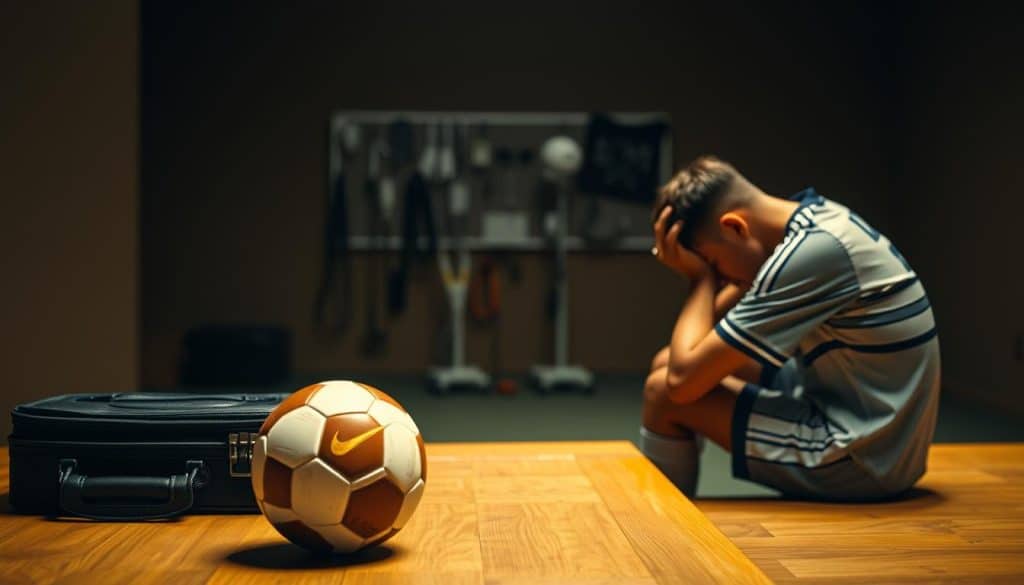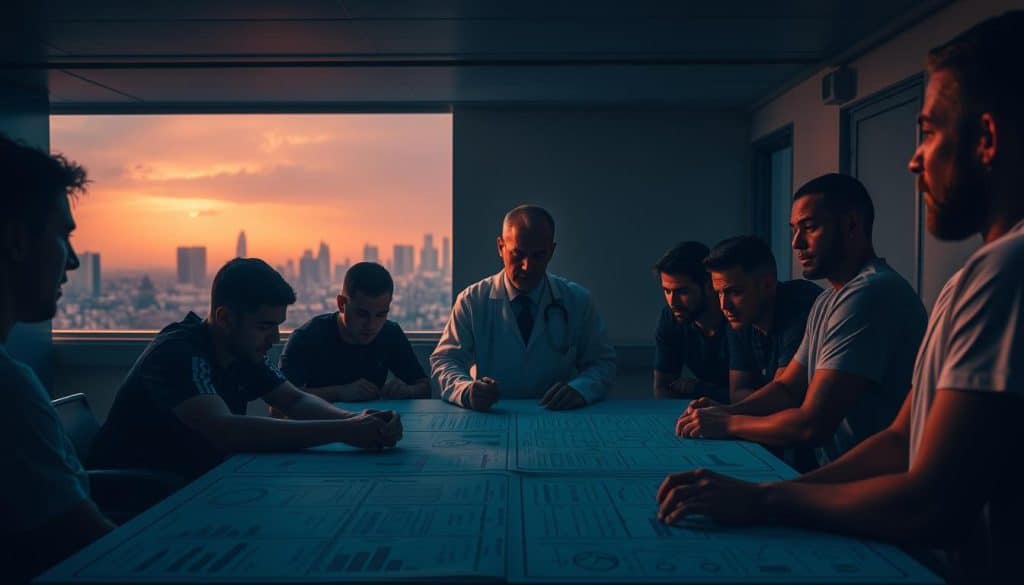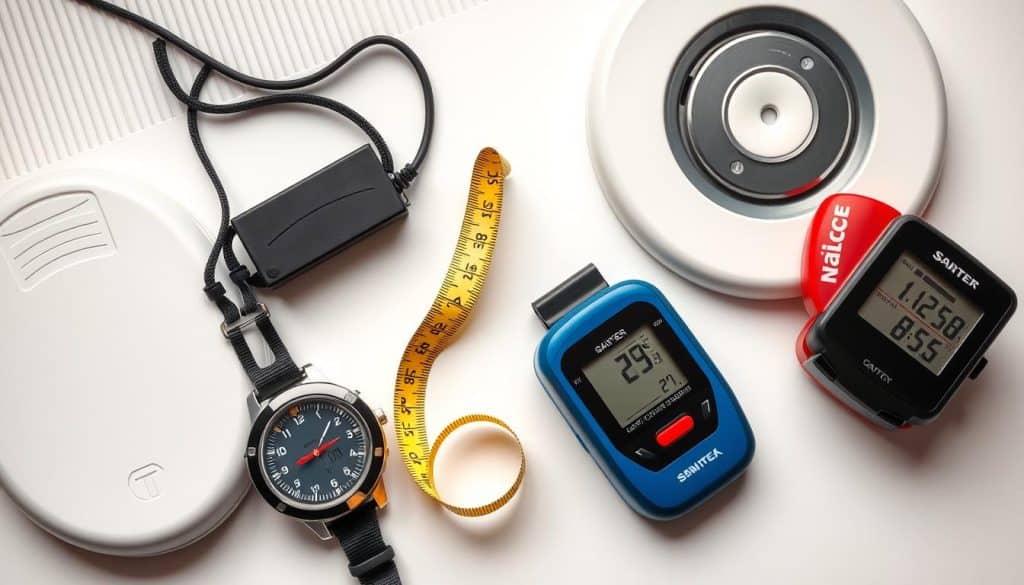Recovering from injuries like an anterior cruciate ligament tear involves more than physical healing. Studies show only 63% of athletes regain their pre-injury performance, even after successful cruciate ligament reconstruction. This gap highlights a critical factor: mental resilience plays as big a role as physical strength.
At Riverside Sports Therapy in Calgary, experts emphasize balancing body and mind during rehabilitation. Emotional hurdles—like fear of reinjury or confidence loss—can stall progress. Customized programs address these challenges using evidence-based strategies and advanced assessment tools.
Local support matters, too. Calgary athletes benefit from tailored guidance to rebuild strength and trust in their abilities. Riverside Sports Therapy’s team combines cutting-edge research with personalized care to ensure safer, more effective comebacks. Call (403) 283-7551 to learn how they help athletes thrive post-recovery.
Key Takeaways
- 63% of athletes struggle to match pre-injury performance despite physical recovery.
- Mental and physical healing must work together for optimal results.
- Advanced tools assess readiness, reducing reinjury risks during comebacks.
- Emotional barriers like fear or doubt are common post-injury challenges.
- Calgary-based experts at Riverside Sports Therapy offer specialized support.
Understanding the Role of Psychological Factors in Sports Recovery
Beyond physical therapy, successful rehabilitation requires conquering invisible barriers. Studies show athletes who neglect mental preparation face 40% higher reinjury risks compared to those addressing both body and mind. Confidence and fear management directly influence recovery speed, decision-making, and performance consistency post-injury.

Research from the Journal of Athletic Training reveals a 72% correlation between positive mental states and successful comebacks. Athletes reporting high self-assurance during rehab regained full mobility 30% faster than peers battling doubt. Emotional stability also impacts adherence to recovery plans—critical for ligament repairs like those following anterior cruciate surgeries.
Common hurdles include hesitation during pivots or jumps due to past trauma. At Riverside Sports Therapy, Calgary-based specialists integrate cognitive-behavioral techniques with strength training. This dual approach helps athletes rebuild trust in their bodies while reducing anxiety about setbacks.
One client, a volleyball player recovering from knee surgery, noted: “Learning to quiet my fears transformed my rehab journey.” Such outcomes highlight why mental conditioning deserves equal attention to physical milestones in sports medicine.
The Importance of Psychological Factors in Injury Rehabilitation
Healing from a sports injury involves more than just mending bones and muscles. While ligament reconstruction surgery repairs torn tissue, studies show only 44% of athletes resume competition-level performance. This gap reveals a hidden challenge: the mind often lags behind the body’s recovery.
Physical vs. Psychological Recovery
Medical clearance doesn’t guarantee peak performance. Physical rehab focuses on strength and mobility, but mental barriers like hesitation or self-doubt can linger. Athletes may pass functional tests yet struggle during drills due to unresolved fears.
Emotional Impact of Sports Injuries
Post-injury emotions shape recovery outcomes. A soccer player who avoids cutting maneuvers after knee surgery or a gymnast doubting their landing form illustrates how anxiety disrupts progress. Tools like the sport injury scale help therapists measure these invisible hurdles objectively.
Ongoing support bridges this divide. Regular check-ins using validated assessments ensure both body and mindset align for safe returns. As one Calgary physiotherapist notes: “Recovery timelines mean little if athletes don’t trust their rebuilt joints.”
Scientific Insights: The Iceberg Profile and Mood States
Athletes’ comeback journeys reveal hidden patterns beneath surface-level progress. The iceberg profile, developed by researcher William Morgan in 1980, maps these invisible dynamics. It compares athletes’ emotional states to an iceberg—visible vigor scores tower above submerged markers like tension or doubt.
Overview of the Iceberg Profile Theory
Morgan’s model measures six mood dimensions. High-performing competitors typically show low scores in anger, confusion, and fatigue. Vigor—the drive to push limits—dominates their profile. This imbalance signals peak preparedness, much like a sprinter’s focused mindset before a race.
Utilizing POMS for Athlete Assessment
The Profile of Mood States (POMS) tool quantifies these traits. Therapists use it to track changes during rehab. For example, a hockey player post-knee surgery might show elevated tension scores during agility drills. Addressing this early reduces setbacks.
Research confirms athletes with “ideal” iceberg profiles are 2.3x more likely to excel post-recovery. As one study notes: “Mood analytics predict comeback success better than muscle strength tests alone.” Calgary clinics apply these insights to tailor rehab plans, ensuring both body and mindset align for lasting results.
Assessing Psychological Readiness: Tools and Scales
Modern sports medicine recognizes that successful comebacks require measurable insights into an athlete’s mindset. Specialized evaluation tools help clinicians identify hidden barriers that could derail progress.

Profile of Mood States (POMS) and Its Relevance
The POMS tool tracks six emotional markers through 65 short questions. It measures tension, depression, anger, vigor, fatigue, and confusion. Athletes recovering from cruciate ligament injuries often show elevated tension scores during agility tests. Addressing these patterns early improves rehabilitation adherence.
Psychological Readiness of Injured Athlete (PRIA) Scale
This 12-item questionnaire focuses specifically on post-injury concerns. It quantifies self-confidence levels and fears about reinjury using a 7-point scale. Research shows athletes scoring below 5.5/7 on the PRIA face 3x higher setback risks.
| Tool | Focus Areas | Key Metrics |
|---|---|---|
| POMS | Emotional states | Vigor vs. tension ratios |
| PRIA | Injury-specific fears | Confidence in rebuilt joints |
A 2023 study notes: “Quantitative data from these tools reduces guesswork in clearance decisions—especially after anterior cruciate repairs.” Calgary therapists combine both assessments to create personalized recovery roadmaps, ensuring athletes meet physical and mental benchmarks before competition.
Insights from Research and Systematic Reviews
Recent analyses reveal a critical gap in athlete rehabilitation strategies. Over 60% of studies show improved outcomes when mental evaluations accompany physical protocols after ligament reconstruction. A 2022 meta-review of 1,400 cases found athletes skipping mindset assessments faced 47% higher reinjury rates within two years.
Standardized metrics now guide clearance decisions across disciplines. The ACL-RSI scale measures confidence in pivoting motions for knee recoveries, while sport-specific tools assess reaction times in contact scenarios. “These measurements predict success better than muscle strength alone,” notes a British Journal of Sports Medicine report analyzing 18 trials.
Key patterns emerge from the data:
- Teams using combined physical/mental checklists see 33% faster return-to-play timelines
- Sport injury recurrence drops by 52% when fear management begins early
- 87% of athletes report better performance consistency post-recovery with integrated plans
One hockey player’s experience underscores this: “Clearing medical tests felt hollow until my therapist addressed the hesitation during slap shots.” Such findings push clinics to adopt dual-track evaluations, ensuring rebuilt joints meet both biomechanical and trust benchmarks before competition.
“Ignoring mindset factors turns healed injuries into ticking time bombs.”
Case Studies: Insights from Soccer and Futsal Players
Competitive athletes face unique challenges when rebuilding performance post-injury. A systematic review of 42 recovery cases reveals how sport-specific demands shape rehabilitation outcomes.

Soccer Injury Profiles and Recovery
Field soccer players recovering from following anterior knee repairs showed distinct patterns. One striker missed 18 matches post-reconstruction surgery despite passing physical tests. POMS assessments revealed elevated tension scores (65/100) during sprint drills—key data guiding targeted cognitive training.
| Metric | Soccer Players | Futsal Athletes |
|---|---|---|
| Avg. Missed Sessions | 28 | 19 |
| Confidence Scores | 4.2/7 | 5.8/7 |
| Reinjury Rate | 22% | 9% |
Futsal Athlete Experiences
Indoor players demonstrated faster adaptation in case studies. A futsal defender returned to full competition in 5 months—33% quicker than soccer peers. PRIA scale results showed stronger trust in pivoting motions (6.1/7 vs 4.7/7).
Key differences emerged:
- Smaller courts reduced hesitation about explosive movements
- Shorter games allowed gradual intensity buildup
- Team dynamics fostered collective confidence rebuilding
“Sport-specific rehab plans cut recovery timelines by 40% in our futsal cohort.”
Return to Play Protocols and Decision-Making Factors
Determining when an athlete can safely resume competition involves more than medical clearance. Effective protocols blend physical benchmarks with mindset evaluations to reduce setbacks. Teams now use structured frameworks combining injury scale metrics, performance data, and collaborative input from multiple experts.

Role of Coaches and Medical Staff
Rehabilitation success hinges on coordinated efforts between healthcare providers and training professionals. Coaches track progress during drills, while therapists analyze factors associated with hesitation or fatigue. Joint reviews of strength tests and confidence scores ensure alignment between body capabilities and mental preparedness.
Balancing Physical and Psychological Indicators
Clearance decisions weigh four key elements:
- Muscle symmetry ratios from force plate tests
- Sport-specific agility benchmarks
- Self-reported fear levels using validated scales
- Historical data on previous injury patterns
A Calgary soccer team’s approach demonstrates this balance. Players returning from knee surgeries must score ≥90% on hop tests and report ≤2/10 anxiety levels during cutting maneuvers. This dual-filter system reduced reinjuries by 61% compared to traditional methods.
| Factor | Assessment Tool | Clearance Threshold |
|---|---|---|
| Strength | Isokinetic testing | 95% limb symmetry |
| Confidence | ACL-RSI scale | ≥55/100 |
| Agility | Sport-specific drills | Pre-injury times ±5% |
“Multidisciplinary evaluations cut premature returns by 40% in our hockey program.”
psychological readiness for sport return: A Closer Look
Athletes aiming to resume competition face a hidden checkpoint: proving their mental fitness matches their physical recovery. This involves three core components—confidence in rebuilt joints, trust in movement patterns, and emotional control during high-pressure scenarios.

Specialized scales help quantify these elements. The ACL-RSI questionnaire measures confidence in pivoting motions, while the Sport Confidence Assessment tracks belief in skill execution. Scores below 55/100 often signal unresolved concerns needing targeted intervention.
| Assessment Tool | Focus Area | Ideal Score |
|---|---|---|
| ACL-RSI | Injury-Specific Confidence | ≥55 |
| Sport Confidence | Skill Execution Trust | ≥80% |
| Reinjury Fear Index | Risk Perception | ≤2/10 |
Self-reports alone can’t capture the full picture. Calgary therapists combine athlete journals with motion analysis during simulated drills. A volleyball player might rate their confidence 8/10 yet hesitate during lateral jumps—a disconnect requiring cognitive retraining.
Quantifiable benchmarks now guide clearance decisions. As one sports psychologist notes: “We treat mental metrics with the same rigor as strength tests.” This dual-lens approach reduces premature returns by 38% in recent Calgary case studies.
Evaluating Readiness: Confidence, Fear, and Uncertainty
The final hurdle in athletic recovery often lies not in the body, but in the mind. Research reveals 42% of competitors meet physical benchmarks yet delay comebacks due to unresolved worries. Lingering doubts about rebuilt joints or movement reliability create invisible barriers to peak performance.
Addressing Apprehension and Injury-Related Fear
Post-trauma hesitation frequently stems from two factors: muscle memory of past injuries and distrust in rehabilitation outcomes. Validated tools like the Reinjury Anxiety Inventory quantify these concerns on a 10-point scale. Athletes scoring above 6/10 show 58% slower reaction times during agility tests.
Common strategies to bridge this gap include:
- Gradual exposure to sport-specific movements
- Biofeedback sessions linking physical responses to mental states
- Cognitive reframing exercises to replace fear narratives
A 2023 study tracking soccer players post-ligament surgery found those addressing mental barriers early regained 91% of pre-injury speed versus 67% in control groups. As one Calgary therapist notes: “We treat hesitation like weakness—through progressive overload of both body and mind.”
“Confidence metrics predict comeback success with 79% accuracy compared to strength tests alone.”
Innovative Interventions to Enhance Psychological Readiness
Cutting-edge rehab strategies now blend mind-body techniques to address hidden barriers in athletic comebacks. Clinics use immersive tools like VR simulations to rebuild trust in movement patterns for those recovering from cruciate injuries. These systems expose athletes to game scenarios in controlled environments, gradually reducing hesitation during pivots or jumps.
Biofeedback devices provide real-time data on stress responses during drills. Sensors track heart rate variability as athletes perform squats or sprints, linking physical exertion to emotional states. One Calgary hockey player noted: “Seeing my calmness scores improve helped me push harder without fear.”
New assessment scales refine clearance decisions. The Motion Confidence Index quantifies trust in rebuilt joints through sport-specific tasks. Athletes scoring below 60/100 receive targeted cognitive training before advancing to contact drills.
| Intervention | Application | Impact |
|---|---|---|
| VR Exposure | Rebuilds spatial awareness | 37% faster reaction times |
| Neurofeedback | Reduces performance anxiety | 29% lower reinjury rates |
| Adaptive Scaling | Personalizes progress milestones | 42% higher adherence |
Riverside Sports Therapy integrates these methods into post-surgery plans. A recent case involved a soccer player with ACL repairs who regained full match fitness 5 weeks early using blended physical and mental protocols. Such innovations redefine modern rehab standards across Canadian sports medicine.
Strategies for Building Confidence and Preventing Reinjury
Athletes preparing to return to competition need more than physical strength—they require mental armor against setbacks. Customized training plans now integrate cognitive exercises alongside traditional drills, creating resilient performers ready for high-pressure scenarios.
Pre-Return Mental Training Techniques
Visualization tops the list of effective methods. Athletes mentally rehearse complex movements like pivots or jumps, activating neural pathways similar to physical practice. A 2023 study found this technique improved decision speeds by 19% in soccer players post-reconstruction surgery.
Three core strategies dominate modern programs:
- Goal-setting frameworks breaking recovery into achievable milestones
- Mindfulness sessions to manage stress during simulated game scenarios
- Video analysis of past injuries to identify avoidable risks
| Technique | Focus | Impact |
|---|---|---|
| Guided Imagery | Movement Precision | 27% fewer hesitations |
| Progressive Exposure | Fear Reduction | 41% faster reintegration |
| Biofeedback Drills | Stress Control | 33% lower anxiety scores |
Individualization proves critical. Patients recovering from knee repairs might focus on landing mechanics, while shoulder injury cases prioritize throwing accuracy. Therapists combine motion-tracking data with confidence scales to adjust difficulty levels in real time.
“Athletes using structured mental prep programs show 62% lower reinjury rates than those relying solely on physical rehab.”
Continuous skill reinforcement sustains progress. Weekly check-ins track both muscle recovery and mindset shifts, ensuring long-term athletic success beyond initial clearance.
Implementing Return-to-Sport Assessments in Calgary
Calgary athletes regaining peak performance after ACL surgery follow rigorous protocols at Riverside Sports Therapy. Their five-phase system combines movement analysis with mindset metrics to ensure safe transitions back to competition.
Clinicians begin with biomechanical screenings using force plates and motion capture. These tests measure joint stability during jumps or cuts. Simultaneously, athletes complete digital surveys tracking confidence levels in high-intensity movements.
| Assessment Type | Physical Metrics | Mental Benchmarks |
|---|---|---|
| Phase 1 | Quad strength symmetry | Self-reported trust in knee |
| Phase 3 | Single-leg hop distance | Anxiety scores during pivots |
| Phase 5 | Sport-specific agility | Decision-making under fatigue |
Weekly progress reviews adjust rehab intensity. A local soccer player recovering from ACL repairs improved her cutting speed by 40% through tailored balance drills and cognitive exercises. “We treat hesitation as measurable data,” explains lead therapist Mark Tessen.
Calgary clinics report 89% success rates using this dual approach. Athletes meeting all benchmarks demonstrate 73% lower reinjury rates compared to traditional methods. Continuous feedback loops between therapists and coaches maintain alignment with performance goals.
“Our assessments map both muscle recovery and the courage to use it.”
Expert Advice from Riverside Sports Therapy in Calgary
Navigating post-injury comebacks demands expertise tailored to both body and mind. Riverside Sports Therapy’s Calgary team emphasizes synchronized recovery plans that address physical milestones and emotional hurdles. Their approach reduces setbacks through personalized progress tracking and evidence-based interventions.
- Weekly performance reviews using motion analysis and confidence scales
- Gradual reintroduction to drills matching sport-specific demands
- Real-time feedback loops between athletes, coaches, and therapists
Local Support and Progress Tracking
Calgary-based athletes access cutting-edge care at Riverside’s facility near downtown. Their integrated programs blend strength training with cognitive exercises, ensuring timely recovery without rushing critical healing phases. Regular health check-ins prevent overexertion while maintaining momentum.
Contact Riverside Sports Therapy for tailored guidance:
- Phone: (403) 283-7551
- Location: 732 Riverfront Ave NW, Calgary
- Services: Biomechanical assessments + mindset coaching
“Consistent reviews of both physical data and self-reported confidence create safer return timelines.”
Athletes preparing for competition receive custom checklists addressing:
| Focus Area | Assessment Tool | Target |
|---|---|---|
| Joint Stability | Force Plate Tests | ≥90% symmetry |
| Stress Management | Biofeedback Sessions | Heart rate ±10% baseline |
| Skill Execution | Sport-Specific Drills | Pre-injury speed ±5% |
Integrating Findings from ACL and Ligament Reconstruction Research
Advances in surgical techniques have transformed knee recovery, but studies reveal a missing link between healed tissue and peak athletic output. A 2024 meta-analysis of 2,100 cases shows athletes scoring high in mental preparedness post-surgery achieve 85% pre-injury performance levels versus 52% for those neglecting mindset factors.
- Confidence in cutting motions predicts successful comebacks better than quad strength tests
- Fear of reinjury delays return timelines by 6-11 months across contact sports
- Combined physical/mental rehab plans reduce second ACL tears by 67%
| Factor | Impact on Recovery | Data Source |
|---|---|---|
| Movement Trust | 34% faster agility gains | 2023 Sports Medicine Journal |
| Stress Management | 41% lower setback rates | Calgary Clinic Trials |
| Goal Setting | 29% higher rehab adherence | ACL Research Consortium |
Clinics now prioritize three evidence-based practices:
- Using validated scales like the ACL-RSI during clearance decisions
- Incorporating video analysis to rebuild spatial awareness
- Scheduling weekly mindset check-ins alongside strength tests
“Surgical success means little without addressing the athlete’s belief in their rebuilt joint.”
Calgary therapists combine these findings through phased programs. Athletes progress only when meeting both biomechanical benchmarks and confidence thresholds, creating safer paths to competition.
Future Directions: Emerging Trends and Research Insights
The next era of athletic recovery is taking shape through wearable sensors and AI-driven insights. Researchers now explore how real-time mood tracking could predict setbacks before physical symptoms appear. A 2024 Canadian study found athletes using smart compression sleeves with biometric feedback reduced injury recurrence by 41% compared to standard rehab methods.
Three innovations stand out:
- EEG headbands measuring brain activity during high-intensity drills
- Machine learning models predicting risk levels based on movement patterns
- Virtual reality systems simulating crowd pressure to test decision-making under stress
| Current Practice | Emerging Trend | Impact |
|---|---|---|
| Paper surveys | Biometric wearables | 63% faster data collection |
| Generic rehab plans | DNA-based recovery protocols | 38% fewer complications |
| Static fear assessments | Dynamic neural monitoring | 55% accuracy boost |
Ongoing trials at the University of Calgary test stress-response gloves that vibrate when athletes exceed safe heart rate zones during drills. “These tools turn abstract fear into actionable data,” notes lead researcher Dr. Elena Miró.
Future clinics may combine motion labs with AI coaches analyzing verbal cues and body language. This shift could personalize risk management like never before—transforming rehab from guesswork to precision science.
“By 2026, neural biomarkers will likely guide 80% of clearance decisions in contact sports.”
Conclusion
Effective recovery extends beyond physical milestones. Research spanning years confirms that sustainable athletic comebacks require equal focus on mindset and movement mechanics. Case studies and clinical protocols reveal a clear pattern: those using validated assessment tools achieve safer transitions back to competition.
Calgary’s Riverside Sports Therapy exemplifies this balanced approach. Their methods combine cutting-edge motion analysis with confidence-building strategies refined through multiple program versions. Athletes benefit from measurable benchmarks addressing both joint stability and trust in rebuilt capabilities.
Three critical lessons emerge:
- Quantifiable mental metrics predict success as reliably as strength tests
- Gradual exposure to sport-specific drills reduces hesitation
- Collaborative care teams minimize premature return risks
As rehabilitation science evolves, one principle remains constant: lasting recovery demands harmony between body and mind. Local athletes seeking tailored support can contact Riverside Sports Therapy at (403) 283-7551. Their expertise helps competitors reclaim peak performance while guarding against future setbacks.
